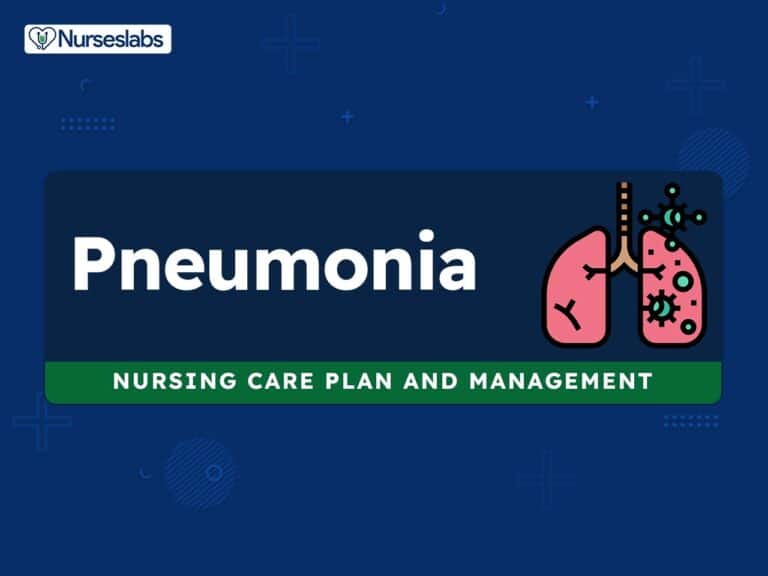This guide discusses the nursing care plans and nursing diagnosis for hypernatremia and hyponatremia. It provides essential information on the assessment, diagnosis, and management of these conditions.
Sodium (Na) Imbalances: Hypernatremia and Hyponatremia
Sodium (Na) is a major extracellular fluid cation. The balance of sodium is important for many physiologic functions that include facilitating impulse transmission in nerve and muscle fibers by participating in the sodium-potassium pump; assists in acid-base balance by combining with bicarbonate and chloride.
The normal serum sodium concentration ranges from 135 to 145 mEq/L.
- Hypernatremia is defined as serum sodium levels above 145 mEq/L.
- Hyponatremia is defined as serum sodium levels below 135 mEq/L.
Nursing Care Plans
Hypernatremia and hyponatremia are common electrolyte imbalances that can affect patients in various healthcare settings. These conditions require prompt recognition and appropriate interventions to prevent complications and improve patient outcomes.
Here are two nursing diagnosis for patients with sodium imbalances: hypernatremia and hyponatremia nursing care plans:
Hypernatremia: Risk For Electrolyte Imbalance
Hypernatremia, an elevated level of sodium in the blood, can occur due to various reasons such as diarrhea, vomiting, diabetes insipidus, renal disease, high protein diet, and side effects of osmotic diuresis. These conditions can lead to a loss of water from the body or an excess of sodium, leading to a risk of electrolyte imbalance. This can affect the normal functioning of cells, muscles, and organs, and may lead to symptoms such as confusion, seizures, and coma.
Nursing Diagnosis
May be related to
- Diarrhea, vomiting
- Diabetes insipidus, renal disease
- Fever, profuse sweating
- High-protein diet
- Side effects of medication such as osmotic diuretics
Possibly evidenced by
- Not applicable. A risk diagnosis is not evidenced by signs and symptoms, as the problem has not occurred and nursing interventions are directed at prevention.
Desired Outcomes
- The client will display heart rate, blood pressure, and laboratory results within the normal limit and absence of neuromuscular irritability and cognitive impairment.
Nursing Assessment and Rationales
1. Monitor respiratory rate and depth.
Metabolic acidosis secondary to hyperchloremia may result in deep, labored breathing with air hunger, which can lead to a cardiopulmonary arrest if left untreated.
2. Monitor blood pressure.
Depending on the fluid status, hypertension or hypotension may be present. The presence of postural hypotension may affect activity tolerance.
3. Monitor the level of consciousness and muscular strength, tone, and movement.
Sodium imbalances may cause changes that vary from irritability and confusion to seizures and coma. In the presence of a water deficit, rapid rehydration may cause cerebral edema.
4. Monitor intake and output and specific gravity. Assess the presence and location of edema. Weigh clients daily.
These parameters are variable, depending on the fluid status, and are indicators of therapy needs and effectiveness.
5. Assess skin turgor, color, temperature, and mucous membrane moisture.
Water-deficit hyponatremia manifest by signs of dehydration.
6. Monitor serum electrolytes, osmolality, and arterial blood gasses, as indicated.
This will evaluate the therapy’s needs and effectiveness.
7. Identify the client at risk for hypernatremia and likely causes such as sodium excess or water deficit.
Early identification and intervention prevent serious complications associated with this problem.
Nursing Interventions and Rationales
1. Provide safety and seizure precautions as indicated such as using padded side rails and putting the bed in a low position.
Cerebral edema and sodium excess increase the risk of convulsions. Seizures and altered mental status are potential complications in patients with severe hypernatremia. Padded side rails and a low bed position can prevent falls and injury during a seizure. Bed alarms, bed pads or mats, and close supervision can also be utilized. Healthcare providers should follow guidelines to ensure patient safety and provide prompt intervention in case of a seizure.
2. Allow debilitated client fluids at regular intervals. Provide free water to a client receiving enteral feedings.
May prevent hypernatremia in a client who is unable to perceive or respond to thirst.
3. Encourage meticulous skin care and frequent repositioning.
Maintains the integrity of the skin. Encouraging meticulous skin care and frequent repositioning is vital for patients with hypernatremia to prevent skin breakdown, pressure ulcers, and complications. Hypernatremia can cause dehydration and increase the risk of skin damage, making it essential to promote optimal skin care and repositioning to prevent further harm.
4. Teach the client to avoid foods high in sodium such as regular canned vegetables and vegetable juices, processed foods, snack foods, and condiments.
Decreases the risk of sodium-associated complications such as stroke, heart disease, and heart failure.
5. Provide frequent oral care. Avoid the use of mouthwash containing alcohol.
Promotes comfort and prevents further drying of mucous membranes.
6. Encourage increased oral and IV fluid intake.
Replacement of total body water deficit will gradually restore sodium and water balance.
7. Restrict sodium intake and administer diuretics as indicated.
Sodium intake restriction while promoting renal clearance decreases serum sodium levels in the presence of extracellular fluid excess.
Hyponatremia: Risk For Electrolyte Imbalance
Hyponatremia, a low level of sodium in the blood, can lead to a risk of electrolyte imbalance, as it may cause water to move into the cells and dilute the low sodium concentration in the extracellular fluid. This shift of water into the cells can lead to swelling and affect their normal functioning, leading to symptoms such as headache, confusion, seizures, and coma. Hyponatremia can occur due to various reasons, including excessive water intake, fluid loss from vomiting or diarrhea, certain medications, and medical conditions affecting the kidneys or hormonal regulation of water balance.
Nursing Diagnosis
- Risk for Electrolyte Imbalance
May be related to
- Diarrhea, vomiting
- Renal dysfunction
- Treatment-related side effects such as medications, gastric suctioning, electrolyte-free intravenous (IV) solutions
- Water intoxication
Possibly evidenced by
- Not applicable. A risk diagnosis is not evidenced by signs and symptoms, as the problem has not occurred and nursing interventions are directed at prevention.
Desired Outcomes
- The client will display heart rate, blood pressure, and laboratory results within the normal limit for the client; absence of muscle weakness; and neurological irritability.
Nursing Assessment and Rationales
1. Monitor respiratory rate and depth.
Co-occurring hypochloremia may produce slow and shallow respiration as the body compensates for metabolic alkalosis.
2. Monitor intake and output; Calculate fluid balance. Weigh clients daily.
Fluid balance indicators are important since either fluid excess or deficit may occur with hyponatremia.
3. Assess the level of consciousness and neuromuscular response.
A deficit in sodium levels may lead to decreased mentation to coma, as well as generalized muscle weakness, cramps, or convulsions.
4. Note for signs of circulatory overload, as indicated
Administration of sodium-containing IV fluids in the presence of heart failure increases risk.
5. Identify the client at risk for hyponatremia and the specific cause such as sodium loss or fluid excess.
Provides clues for early intervention. Hyponatremia is a common imbalance, especially in the elderly, and may range from mild to severe. Severe hyponatremia can cause neurological damage or death if not treated properly.
6. Monitor serum and urine electrolytes and osmolality.
Evaluates therapy needs and effectiveness.
Nursing Interventions and Rationales
1. Provide safety and seizure precautions. Maintain a calm, quiet environment.
Decreases CNS stimulation and risk of injury from neurological complications such as seizures.
2. Irrigate the nasogastric tube (when used) with normal saline instead of water.
The use of isotonic solution during irrigation decreases gastrointestinal electrolyte losses.
3. Encourage fluids and foods high in sodium such as meat, milk, beets, celery, eggs, and carrots. Use fruit juices and bouillon instead of water.
Unless sodium deficit causes serious symptoms requiring immediate IV replacement, the client may benefit from slower replacement by oral method or removal of previous salt restriction.
4. Provide or restrict fluids, depending on fluid volume status.
In the presence of fluid excess or SIADH, fluid restriction is indicated while in the presence of hypovolemia, volume losses are replaced with isotonic saline, or, on occasion, hypertonic solution when the hyponatremia is life-threatening.
5. Administer medications, as indicated:
- 5.1. Captopril (Capoten)
May be used in combination with a loop diuretic (e.g., Lasix) to correct fluid volume excess, especially in the presence of heart failure.
- 5.2. Demeclocycline (Declomycin)
Helpful in treating chronic SIADH, or when severe water restriction may not be tolerated.
- 5.3. Furosemide (Lasix)
Useful in reducing fluid excess to correct sodium and water balance.
- 5.5. Sodium chloride
Used to replace deficits in the presence of chronic or ongoing losses.
6. Prepare for/assist with dialysis as indicated.
May be done to restore sodium balance without increasing fluid levels when the hyponatremia is severe or the response to diuretic therapy is inadequate.
Recommended Resources
Recommended nursing diagnosis and nursing care plan books and resources.
Disclosure: Included below are affiliate links from Amazon at no additional cost from you. We may earn a small commission from your purchase. For more information, check out our privacy policy.
Ackley and Ladwig’s Nursing Diagnosis Handbook: An Evidence-Based Guide to Planning Care
We love this book because of its evidence-based approach to nursing interventions. This care plan handbook uses an easy, three-step system to guide you through client assessment, nursing diagnosis, and care planning. Includes step-by-step instructions showing how to implement care and evaluate outcomes, and help you build skills in diagnostic reasoning and critical thinking.

Nursing Care Plans – Nursing Diagnosis & Intervention (10th Edition)
Includes over two hundred care plans that reflect the most recent evidence-based guidelines. New to this edition are ICNP diagnoses, care plans on LGBTQ health issues, and on electrolytes and acid-base balance.

Nurse’s Pocket Guide: Diagnoses, Prioritized Interventions, and Rationales
Quick-reference tool includes all you need to identify the correct diagnoses for efficient patient care planning. The sixteenth edition includes the most recent nursing diagnoses and interventions and an alphabetized listing of nursing diagnoses covering more than 400 disorders.

Nursing Diagnosis Manual: Planning, Individualizing, and Documenting Client Care
Identify interventions to plan, individualize, and document care for more than 800 diseases and disorders. Only in the Nursing Diagnosis Manual will you find for each diagnosis subjectively and objectively – sample clinical applications, prioritized action/interventions with rationales – a documentation section, and much more!

All-in-One Nursing Care Planning Resource – E-Book: Medical-Surgical, Pediatric, Maternity, and Psychiatric-Mental Health
Includes over 100 care plans for medical-surgical, maternity/OB, pediatrics, and psychiatric and mental health. Interprofessional “patient problems” focus familiarizes you with how to speak to patients.

See also
Other recommended site resources for this nursing care plan:
- Nursing Care Plans (NCP): Ultimate Guide and Database MUST READ!
Over 150+ nursing care plans for different diseases and conditions. Includes our easy-to-follow guide on how to create nursing care plans from scratch. - Nursing Diagnosis Guide and List: All You Need to Know to Master Diagnosing
Our comprehensive guide on how to create and write diagnostic labels. Includes detailed nursing care plan guides for common nursing diagnostic labels.
Other nursing care plans related to endocrine system and metabolism disorders:
- Acid-Base Balance
- Addison’s Disease | 3 Care Plans
- Cushing’s Disease | 6 Care Plans
- Diabetes Mellitus Type 1 (Juvenile Diabetes) | 4 Care Plans
- Diabetes Mellitus Type 2 | 20 Care Plans UPDATED!
- Diabetic Ketoacidosis (DKA) and Hyperglycemic Hyperosmolar Nonketotic Syndrome (HHNS) | 4 Care Plans
- Eating Disorders: Anorexia & Bulimia Nervosa | 7 Care Plans
- Fluid and Electrolyte Imbalances
- Gestational Diabetes Mellitus | 4 Care Plans
- Hyperthyroidism | 7 Care Plans
- Hypothyroidism | 3 Care Plans
- Obesity | 5 Care Plans
- Thyroidectomy | 5 Care Plans




































Leave a Comment